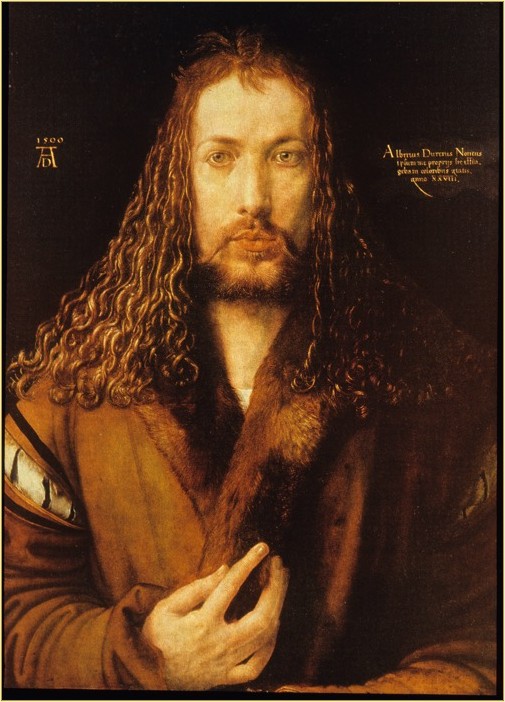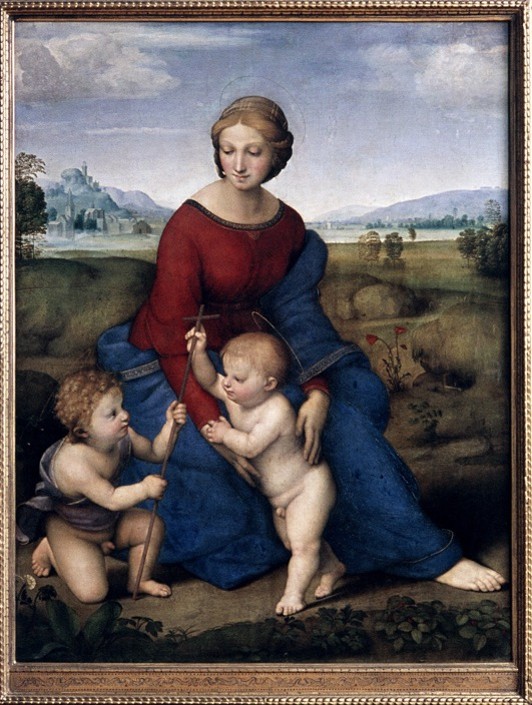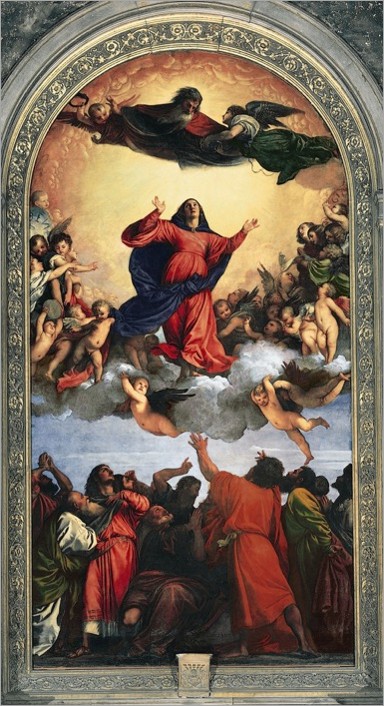背景:文艺复兴全盛期
The pivot of the “High Renaissance”.
- 新教与个人主义(Protestantism and Individualism):信仰与救赎依靠个人与上帝之间的直接关系,而非通过教会层级与圣礼。欧洲宗教统一被打破:北欧(德意志部分区域,瑞士,荷兰,英国)多为新教,南欧(意大利,西班牙,葡萄牙)与法国大部多为天主教。
- 天才艺术家(the artist as genius)
- 神圣的人类创造(the divinity of human creation):比如理想人体与宇宙秩序相合。
北部绘画与版画艺术
丢勒(Dürer):艺术天才与印刷业兴起(the rise of print business)=>《自画像》self-portrait,1500:自我基督化
=>《人的堕落》Fall of Man (Adam and Eve),1504,铜版雕刻 engraving。可以复制并传播的版画使艺术进入更广阔的市民与跨地域市场,促进了印刷业的兴起。

=>《伊森海姆祭坛画》Isenheim Altarpiece,1510 - 15:对基督受难极其科学,现实的描绘,激起病人(多为皮肤病,如麦角中毒 —— 圣安东尼之火)的共情。
老布吕赫尔(Bruegel):风景画(landscape)=>《尼德兰箴言》Netherlandish Proverbs,1559
=>《雪中的猎人》Hunters in the Snow,1565
罗马 & 佛罗伦萨的绘画与雕塑艺术
达芬奇(Leonardo da Vinci)的人文宇宙观(humanist cosmology)=>《维特鲁威人》Vituvian Man,1490:已经成为了西方历史的标志性图像,是科学与艺术理想的独特综合。
=>《最后的晚餐》Last Supper,c. 1505 - c. 1612,恩宠圣母修道院食堂:线性透视,平行线交于耶稣之眼。三扇窗营造 chiaroscuro。实验性的灰泥蛋彩,结果很快 deteriorate。
=>《蒙娜丽莎》Mona Lisa,c. 1503 - 06:姿势为男子常用,体现出其主体独立性。
=>《大卫》David,1501 - 04
=>《囚徒》Captives,1513 - 16,教皇尤利乌斯二世(Pope Julius II)陵墓:夸张的肌肉与扭曲的姿态表现出强烈的内在张力与崇高可畏感(terribilità)
=> 西斯廷天顶与墙画(ceiling and wall of the Sistine Chapel),1508 - 1
- 大量 ignuidi 裸体青年的应用,表现出人类的尊严与神性,灵魂与肉体的张力。
- 圣巴尔多禄茂手中的人皮是米开朗基罗的面孔:艺术家的代入;真正的自我在灵魂而非肉体。
=>《雅典学院》The School of Athens,1510 - 11,湿壁画;其「男性理想」:理性社群。
=>《巴尔达萨雷·卡斯蒂廖内》Baldassare Castiglione,c. 1515,油画;尊严,智慧,含蓄,内在德性。
=>《草地上的圣母》Madonna of the Meadow,1505,油画;母性,神圣,亲切而高贵。

威尼斯绘画艺术:提香的北部笔触
提香(Titian)与威尼斯色彩主义=>《圣母蒙召升天》Assumption of the Virgin Mary,1518,圣方济会荣耀圣母教堂(Basilica of Santa Maria Gloriosa del Frari)
- 戏剧性:表情,姿势各异,强烈生动
- 动态感:下,中,上三层,对角线运动,流畅且相互呼应

=>《乌比诺的维纳斯》Venus of Urbino,c. 1538
- 并非传统的神话裸体:将维纳斯世俗化,突出人体质感,感官魅力
- 象征物:花暗示爱情与美神维纳斯,小狗象征忠贞
矫饰主义与风格化
Mannerism is characterized by elongated proportions, exaggerated poses, artificial elegance, and often unsettling spatial complexity. Instead of the calm balance and harmony of classical Renaissance art, Mannerist works emphasize tension, sophistication, and stylization, reflecting the uncertainty and turbulence of the period.
=>《下十字架》Deposition,1528,Jacopo Pontormo:复杂姿势,不稳定空间,奇异色彩
=>《圣儒斯蒂娜殉道》Martyrdom of Santa Giustina,1575,Paolo Veronese:舞台化
本节名录
- 1517: Martin Luther, a German monk, posts his 95 theses (《九十五条论纲》) on the doors of Wittenberg Cathedral, leading to the Protestant Reformation (宗教改革) that splits Christianity in Europe
- 1550: Giorgio Vasari publishes Lives of the Most Eminent Painters, Sculptors, and Architects, the first art historical book in the west, focused on biography
- woodcut (木版画): a printmaking technique developed in the Middle Ages: an image is carved in relief on a wooden block, then inked and pressed against a dry sheet of paper
- engraving (雕刻版画): a printmaking technique developed in the 15th century: an image is carved into a metal plate, which is then inked and squeezed tightly against a damp sheet of paper in a high-pressure printing press (高压印刷机)